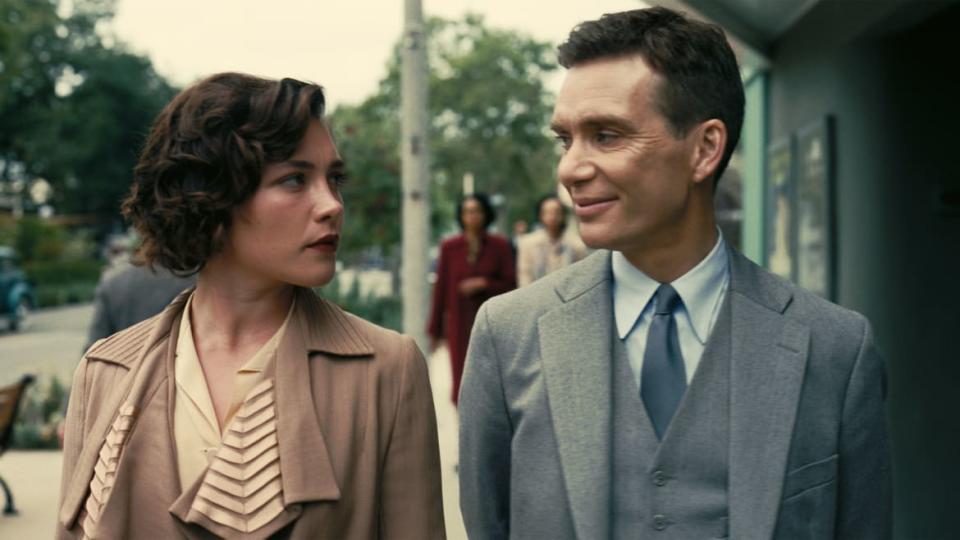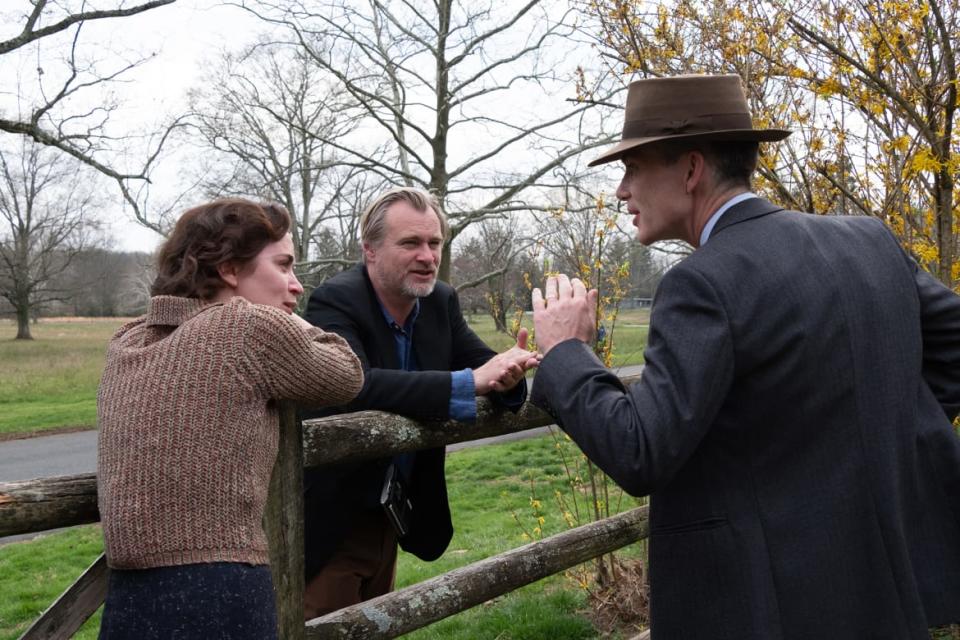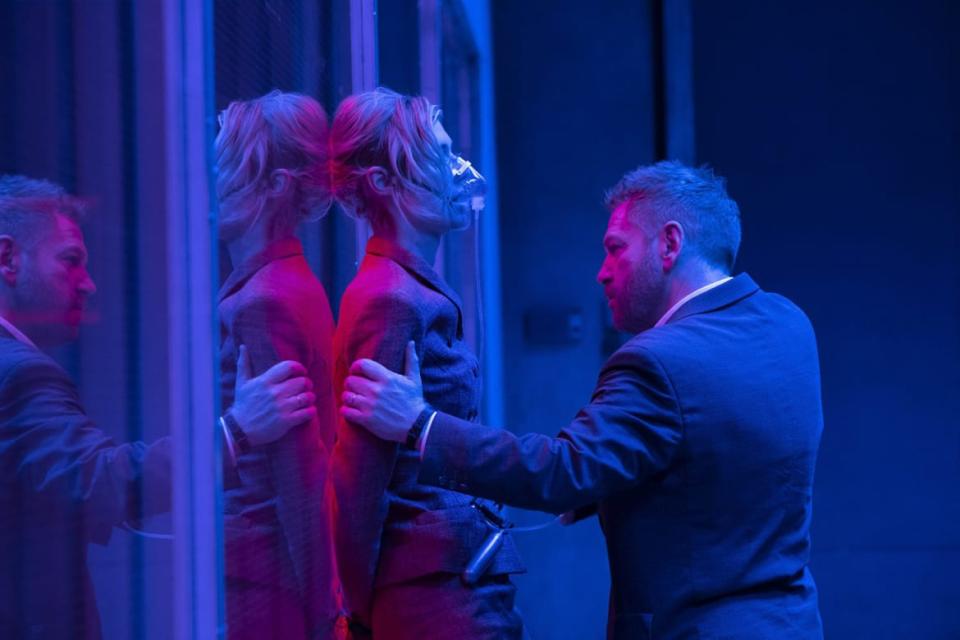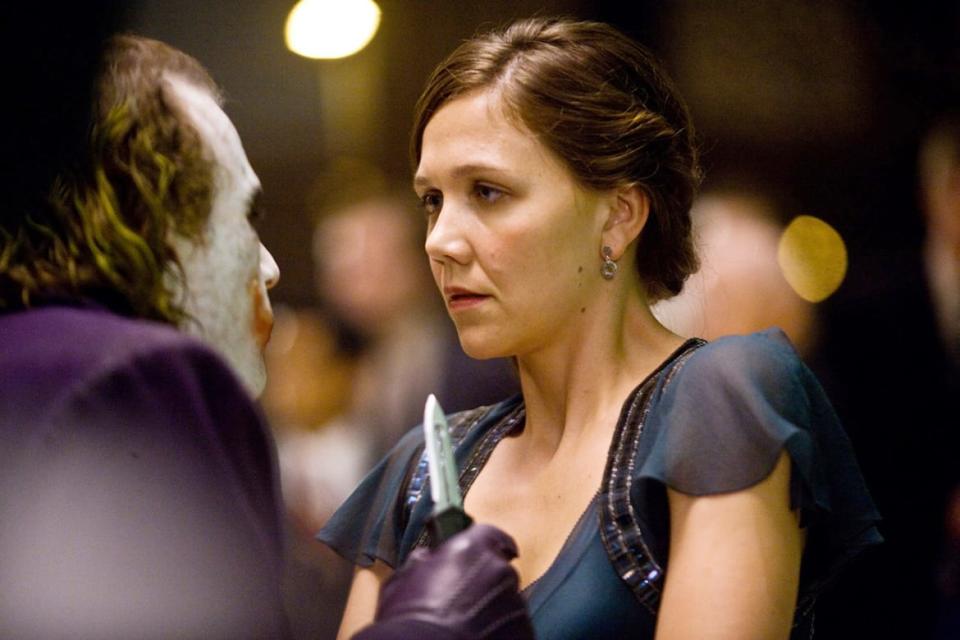Chris Nolan Is the Perfect Director for a Sex-Starved Era in Film

In a Christopher Nolan film, even the sex has to feel intellectual.
Much has been made of the bizarre intimacy scenes in Oppenheimer, and understandably so. Romance is rare in Nolan’s filmography, and this film contains the first sex scenes in the director’s career—which might explain why their execution could most kindly be described as “jarring.” (When was the last time you went to the multiplex and watched someone read a sacred text off of a woman’s breasts?)
Paradoxically, however, Nolan’s sex allergy might have benefited his career. At least, it befits this era in film, as the erotic thriller continues to atrophy and romantic comedies are still languishing. Meanwhile, sex scenes are disappearing—and discussions that keep cropping up about whether they’re really “necessary.” Over and over, the implication seems to be that a sufficiently smart film should not need cheap thrills like sex scenes.
The ‘Oppenheimer’ Sex Scenes Are Cringey, But Not Because of the Sex
Who better to become the soothsayer of superhero cinema and an increasingly sparse, sex-averse era of film than a man who, like far too many filmgoers these days, seems uninterested in exploring intimacy for its own sake?
It’s not every day that a woman’s chest gets used as a literal billboard, but there Florence Pugh is in Oppenheimer’s first sex scene—breaking from Cillian Murphy’s J. Robert Oppenheimer mid-coitus so that her character, his longtime lover Jean Tatlock, can peruse his impressive bookshelf and return with the Bhagavad Gita. When she returns to bed, she holds the book in front of her breasts so that he can read off the inevitable allusion while they resume their love-making.
“Now I am become death,” Oppenheimer murmurs oh-so seriously. “The Destroyer of Worlds.” The moment is so ridiculous, it almost feels like an intentional gag.

Florence Pugh and Cillian Murphy in Oppenheimer.
And yet, somehow, this is not the silliest sex scene in Oppenheimer. That comes later, when the physicist’s long-suffering wife, Katherine, aka “Kitty” (Emily Blunt), watches government officials interrogate her husband while imagining Jean riding him right there at the table. Narratively, the flourish makes some sense, as the discussion in that moment has turned toward Oppenheimer’s illicit trysts. Tonally, however, this choice feels like a sudden and singular break from the film’s established style—more “edgy” (in the emptiest sense of that word) than illuminating.
The problem with the sex scenes in Oppenheimer is multi-layered. Beyond the awkward scenes themselves, the underlying issue remains that Nolan has never excelled at writing female characters like they’re actual, living people. He seems more comfortable with tropes—like, in Oppenheimer’s case, the hysterical woman and the long-suffering wife.
As skillfully as Nolan can interweave timelines and illuminate the metaphysical questions that haunt his many, many male protagonists, his female characters are generally as flat as they come. If they’re not dead before the movie starts, they’ll probably wind up that way by the end—or, at the very least, they’ll experience mistreatment in order to properly motivate the film’s protagonist.
For example: In Nolan’s previous film, Tenet, Elizabeth Debicki’s character, Kat, faces constant abuse from her husband, which provides motivation for the film’s unnamed “Protagonist” (John David Washington). Kat’s resolve despite her situation is striking, and in the end, she gets the last word—which might prompt some to see her as one of those coveted “strong female characters.” At the same time, that feeling of entrapment seems to be the only thing that defines Kat; beyond her grit, her identity seems to boil down to being a mother, so much so that when faced with the complete annihilation of the world and human race as we know it, her only response is, “Including my son.”

Emily Blunt with writer, director, and producer Christopher Nolan and Cillian Murphy on the set of Oppenheimer.
Women in Nolan films tend to function as two-dimensional plot devices. They’re often either intermediaries or collateral damage in battles fought by two complicated men. (See: Hilary Swank in Insomnia; Debicki in Tenet; Scarlett Johansson in The Prestige; and the Dark Knight trilogy’s Rachel Dawes, played first by Katie Holmes and then by Maggie Gyllenhaal.) The protagonists in Nolan’s film are also often tortured by their failures with respect to the women and girls in their lives, as in Memento, Inception, and Interstellar.
Unsurprisingly, given its genre and subject matter, Nolan’s World War II film Dunkirk featured only two women with speaking roles; together, the pair uttered a total of 47 words.
The Biggest Problem With ‘Oppenheimer’: Everyone Is Too Damn Sexy
It would be inaccurate, however, to say that Nolan has no sense of romance. As platonic as their bond might be, Robert Pattinson and John David Washington’s goodbye at the end of Tenet is as loving as they come. (A bittersweet goodbye followed by the promise of seeing one another again, in another dimension, in another time? Someone hand me a tissue, please!) And it would also be unfair to say that Nolan has never imbued a female character with humanity: Jessica Chastain, at least, had some interesting work to do as Murph in Interstellar—although, perhaps crucially, she’s the protagonist’s daughter and therefore not a possible love interest.
As tempting as it might be to frame Nolan’s stilted portrayals of women and sex as a deficit in skill, the real cause feels more like lack of interest—which might be why he’s been able to skirt substantive critique on this matter for so long. Nolan likes to play with limited perspectives, and like it or not, all of his major characters are men—and so, the argument goes, the women in these stories are naturally limited by the way the men in their lives perceive them. Did anyone really expect Dunkirk to be woman-driven?

Elizabeth Debicki and Kenneth Branagh in Tenet.
All of that is well and good, but it’s nonetheless telling that a creator so often touted as one of the best in his generation has yet to demonstrate even a rudimentary understanding of, or basic interest in, one-half of the human race. It’s also fascinating to observe how his ascent has coincided with the industry’s declining interest in portraying sex and romance—although certainly neither one is required in order to humanize and center female characters.
When Nolan soared from respected independent filmmaker to superstar director in the mid-2000s with his Dark Knight trilogy, the erotic thriller had just gasped its final breaths. The romantic comedy was also on life support. Nolan’s Batman Begins and especially The Dark Knight ignited mainstream public interest in comic-book films—and in 2008, two months before The Dark Knight’s release, Marvel debuted Iron Man. As Hollywood has increasingly tied its funding to projects based on pre-existing IP, well-funded original works have become vanishingly rare.
This brings us back to Oppenheimer, which, along with Barbie, has lit up the box office since its debut last week—even as viewers come away laughing at its sex scenes.
Speaking with Insider, Nolan said that he was “appropriately nervous” when approaching his first sex scenes. At the same time, he noted, Oppenheimer’s way with women was “an essential part of his story”—as was his fixation on Jean. “So it felt very important to understand their relationship and to really see inside it and understand what made it tick without being coy or elusive about it,” Nolan said, “but to try to be intimate, to try and be in there with him and fully understand the relationship that was so important to him.”

Heath Ledger and Maggie Gyllenhaal in The Dark Knight.
But Nolan stumbles in that endeavor, offering only a few disjunct glimpses that speak more to an intellectual bond than a romantic interest. Plenty of people can be intellectually compatible, but it’s never clear what about Jean or Robert attracts each of them to the other in a deeper sense. That relational core is also missing with Oppenheimer’s wife, Kitty, who springs to his defense in the film’s third act. Given all the ways her husband has betrayed her, and the absence of any time spent with the couple in their downtime, the fire behind Kitty’s speech—a testament to Blunt’s skill as an actor—ultimately feels unearned.
Was the ‘Barbie’ and ‘Oppenheimer’ Double Feature Worth It?
After her initial rendezvous with Oppenheimer, Jean winds up infantilized and hysterical in ways that recall Marion Cotillard’s Mal in Inception. Real life obviously dictated the character’s trajectory (she was depressed in real life and died by suicide), but Nolan fails to animate Jean with any motivation outside those struggles. While Oppenheimer gets to be existentially plagued and a genius, and an art aficionado, and a father, and and and, Jean, like so many other Nolan women, merely exists as the man she loves experiences her. In the end, she’s little more than a tragic figure in someone else’s story—another under-explored world, destroyed by a man whose story our director considers more important.
Get the Daily Beast's biggest scoops and scandals delivered right to your inbox. Sign up now.
Stay informed and gain unlimited access to the Daily Beast's unmatched reporting. Subscribe now.

 Yahoo News
Yahoo News 
